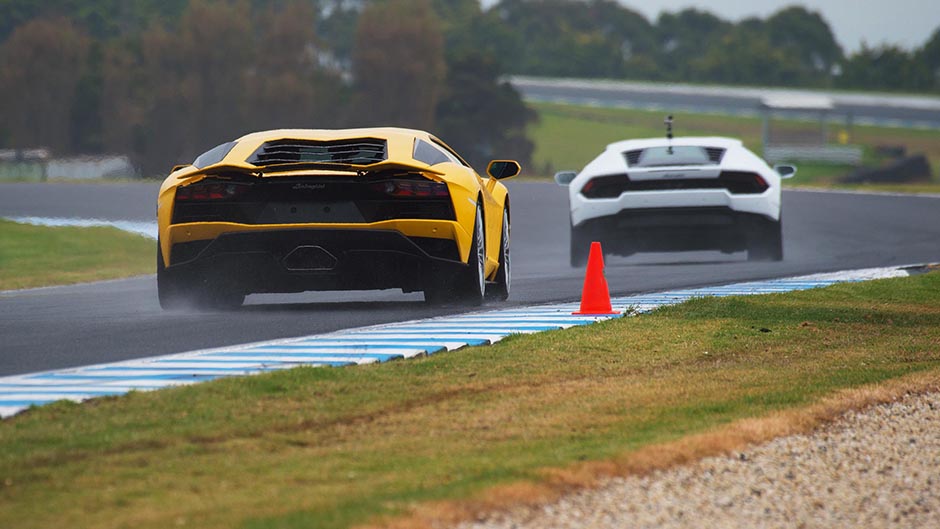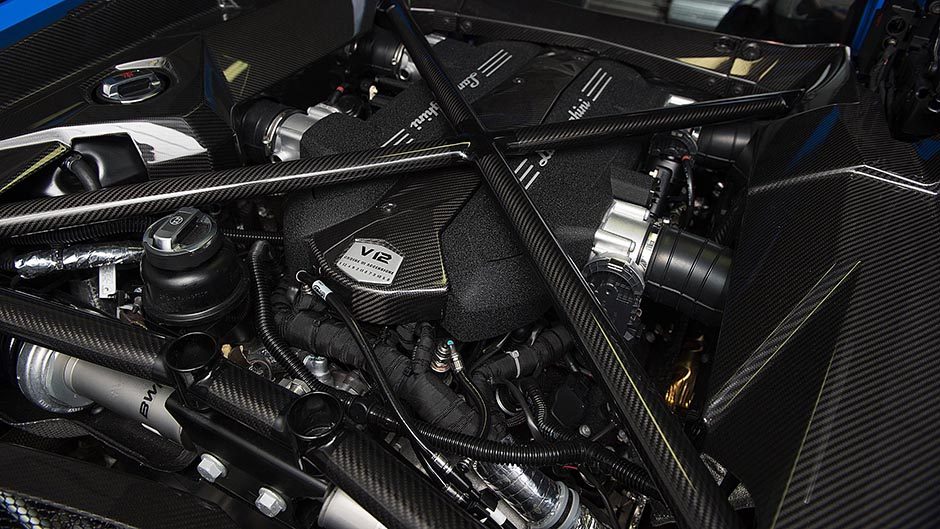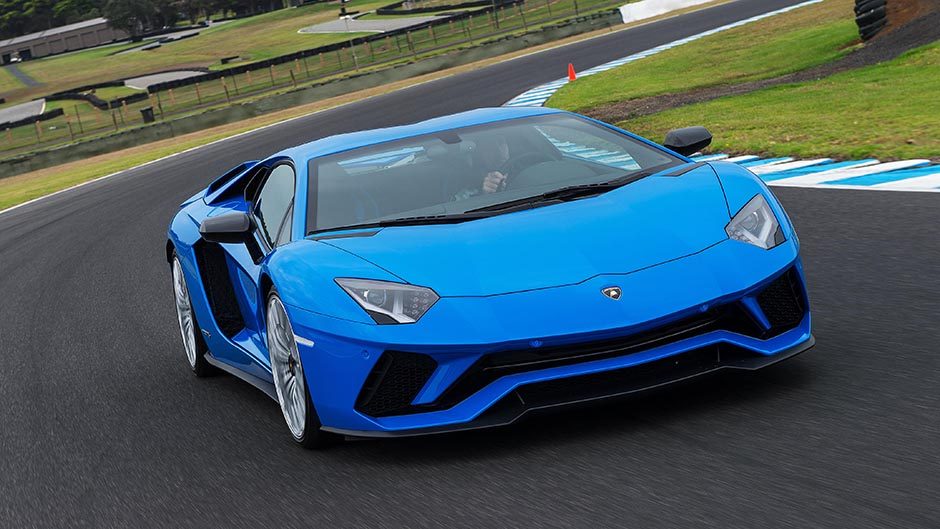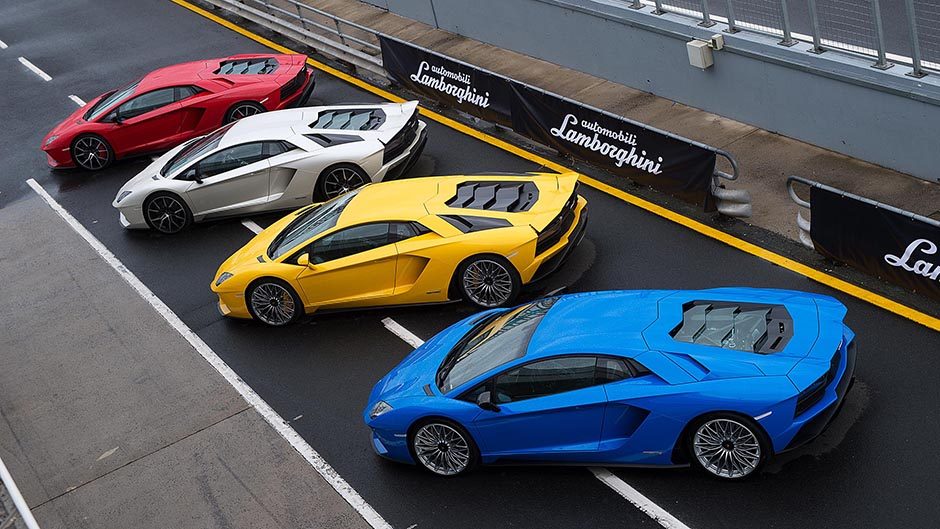We’re strapped into Lamborghini’s new 730bhp Aventador S, about to head out onto the fabulously fast and flowing Phillip Island GP circuit, and it’s raining. What could possibly go wrong?
Well, thankfully nothing. None of the cars was reduced to a mangled pile of carbon and alloy, due in part to an indemnity form we all signed that likely had us liable for repairs. No, it’s due mainly to the all-round improvements Lamborghini has made to the Aventador S.
The S is what you’d call a major facelift of the Lamborghini flagship, which has been around since 2011. Officially they tell us the S stands for ‘something that is better’ in that Lamborghini has refined the design and the aeros, added more power and improved the driveability of the biggest bull.
Daniele Cenciarelli, the project leader on the new S, took us through the technical highlights. While the overall shape of the Aventador remains the same, the ends have been reimagined. The front is said to have been inspired by a shark, while the fangs in the lower valance are influenced by venomous snakes, so we guess you could call the look snarky, though it’s one that is now more aero-efficient. The bigger splitter adds more downforce at speed while the bumper blower ducts help channel the air down the sides via the wheel arches to reduce turbulence. This also flows more air into the rear-mounted radiators to aid cooling. Work to the undertray sees vortex generators added in front of the wheels to improve the airflow through to the larger rear diffuser. Along with a new active rear wing, this gives the S more downforce when needed or, when the spoiler moves to its most slippery setting, creates less drag at speed. Topped out, the S will apparently reach 340km/h.

They’ve milked more from the 6.5-litre V12, which still breathes unassisted, but now delivers 544kW with torque out to 690Nm at 5500rpm. The gains have been made higher in the rev range, and what a spinner this is, the engine ceiling lifted further to 8500rpm thanks to revisions to the variable valve timing and improvements to the variable intake. Software tweaks, the improved supply of air and a new, lighter exhaust system help too.
We’ve all seen those videos of Aventadors flaming from the rear in traffic due to excessive revving by owners. Cenciarelli says this is due primarily to the fitment of aftermarket exhausts, but also that this new exhaust will better handle the heat. And it’s still outrageously loud, especially on start-up when you’re standing next to it in the garage.
The seven-gear single-clutch transmission remains, Cenciarelli saying it’s the best solution in terms of shift speed and weight while reiterating he thinks a twin-clutch would be too heavy in this package. They’ve refined the software for smoother take-offs and changes in auto mode and quicker shifts at speed. Acceleration claims to 100 are unchanged at 2.9sec, though they say it’s a little faster to 200 (8.8sec), with 300 realised in 24.2sec.

There are now more active systems on board, including rear-wheel steering. With new knuckles and two electrically actuated motors on the lower rear suspension arm, the rear wheels can move either in the opposite direction to the fronts at lower speeds, or move in the same direction at higher speeds. Combined with variable ratio steering (a quick 2.2 turns lock-to-lock), it makes the Aventador turn more easily, while the virtual lengthening of the wheelbase at higher speeds in longer sweepers aids stability. We wound the car through a slalom on a wet skid pan and could certainly feel the benefits of the rear wheels lending a hand to get around the tight turns more easily, while the quick steering relieves the pressure on the arms.
The software for the variable AWD has been reconfigured to work in better harmony with the RWS and can send 90 per cent of the shove to the rear wheels in Sport mode. Pirelli has developed new tyres for the car to capitalise on the rear steering capabilities too with new sidewall construction and compounds for the outer shoulder. The suspension set-up gains new springs and geometry in the rear and uses the latest generation of magnetic ride adaptive dampers.With revised bushings, this gives a more controlled ride quality, which still feels very firm even out on a smooth race track. Lamborghini has also added a fourth driving mode in Ego, joining the Strada, Sport and Corsa settings. It’s essentially an individual setting to allow you to tune the powertrain, steering and suspension to your liking. And finally the central control unit responsible for all the active systems has been updated for more harmonious and quicker responses. Lamborghini says that despite the increase in specification, like the RWS, the dry weight of the S is the same at a claimed 1575kg as weight was saved on other components like the exhaust and standard fitment of carbon brakes.

As mentioned, cats and dogs were falling freely on the track as we headed out. Using all wheels to deploy the horses is a definite advantage in conditions like these and as long as the steering was pointing straight ahead, the S hooked up all of its grunt with brutal effect. It’s not a lightweight, but the S really punches hard, the response from the free-breathing V12 astounding, no matter what gear you’re in. With the tricky conditions and the razor responses, Sport mode made things a little easier to manage, while the max-attack Corsa mode required a very smooth approach on all the inputs. It has been a while since we drove the Aventador but the first full-bore upshift quickly reminded us of the nature of these single-clutch automated gearboxes with a violent head-snapping jerk. The gear shifts just aren’t as quick or slick as the best twin-clutch transmissions and still require a slight lift of the throttle pedal to help smooth the change. There’s no issue with the power delivery though, which just keeps pouring out right up past 8000rpm, as does the noise, which gets louder and sweeter. It wouldn’t be our first choice for a track car, but the Aventador is always an exhilarating experience.
The challenging conditions did limit our chances to fully appreciate the intricacies of the rear wheel steering, though we did experience a late afternoon hot lap with V8 Supercar driver, Tony D’Alberto, behind the wheel on a drying track. He commented that the assistance from the rear through the slower turns takes some getting used to but it does help turn the car more quickly and, like us, he loved the power delivery, grip and general stability of the big wide supercar.

The cabin is largely the same, save for a new TFT screen and the addition of CarPlay. Pedals remain offset, the cabin immensely wide yet short on headroom despite the seat set to the lowest position. The switchgear is looking dated while the addition of a USB port to the side of the transmission tunnel looks plain weird. However, like the exterior design, the cabin still looks suitably dramatic, especially with its entrance via the upswinging doors. And to go with those wild looks and stratospheric outputs is the price, the S starting at $659,932 before you start ticking options.
| Model | Lamborghini Aventador S | Price | $659,932 |
| Engine | 6498cc, V10, 544kW/690Nm | Drivetrain | 7-speed automated manual, AWD |
| Fuel Use | 16.9L/100km | C02 Output | 394g/km |
| 0-100km/h | 2.90sec | Weight | 1575kg |


